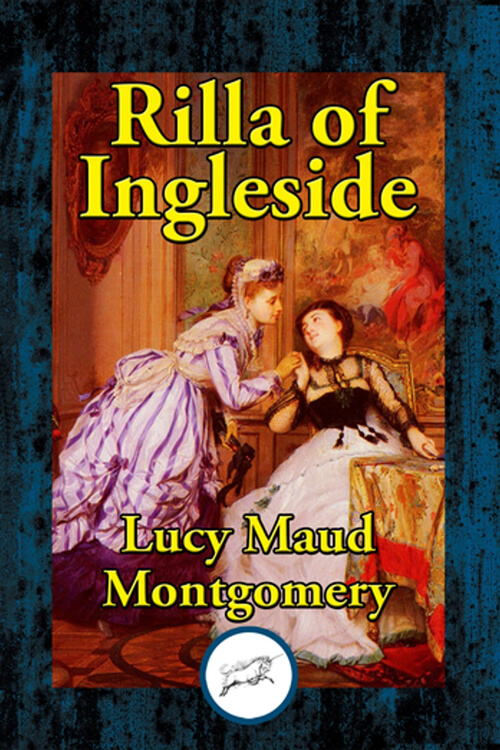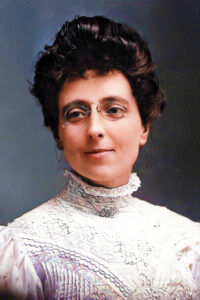
Rilla of Ingleside
It was a warm, golden-cloudy, lovable afternoon. In the big living room at Ingleside, Susan Baker sat down with a certain grim satisfaction hovering about her like an aura; it was four o’clock and Susan, who had been working incessantly since six that morning, felt that she had fairly earned an hour of repose and gossip. Susan just then was perfectly happy; everything had gone almost uncannily well in the kitchen that day. Dr. Jekyll had not been Mr. Hyde and so had not grated on her nerves; from where she sat she could see the pride of her heart— the bed of peonies of her planting and culture, blooming as no other peony plot in Glen St. Mary ever did or could bloom, with peonies crimson, peonies silvery pink, peonies white as drifts of winter snow. Susan had on a new black silk blouse, quite as elaborate as anything Mrs. Marshall Elliott ever wore, and a white starched apron, trimmed with complicated crocheted lace fully five inches wide, not to mention insertion to match. Therefore Susan had all the comfortable consciousness of a well-dressed woman as she opened her copy of the Daily Enterprise and prepared to read the Glen “Notes” which, as Miss Cornelia had just informed her, filled half a column of it and mentioned almost everybody at Ingleside. There was a big, black headline on the front page of the Enterprise, stating that some Archduke Ferdinand or other had been assassinated at a place bearing the weird name of Sarajevo, but Susan tarried not over uninteresting, immaterial stuff like that; she was in quest of something vital. Oh, here it was— “Jottings from Glen St. Mary.” Susan settled down keenly, reading each one over aloud to extract all possible gratification from it. Mrs. Blythe and her visitor, Miss Cornelia—alias Mrs. Marshall Elliott —were chatting together near the open door that led to the veranda, through which a cool, delicious breeze was blowing, bringing whiffs of phantom perfume from the garden, and charming gay echoes from the vine-hung corner where Rilla and Miss Oliver and Walter were laughing and talking. Wherever Rilla Blythe was, there was laughter. There was another occupant of the living room, curled up on a couch, who must not be overlooked, since he was a creature of marked individuality, and had the distinction of being the only living thing whom Susan hated. All cats are mysterious but Dr. Jekyll and Mr. Hyde—“Doc” for short— was trebly so. He was a cat of double personality—or else, as Susan vowed, he was possessed by the devil. To begin with, there had been something uncanny about the very dawn of his existence.
Read or download Book
Lucy Maud Montgomery
Lucy Maud Montgomery OBE (November 30, 1874 – April 24, 1942), published as L. M. Montgomery, was a Canadian author best known for a collection of novels, essays, short stories, and poetry beginning in 1908 with Anne of Green Gables. She published 20 novels as well as 530 short stories, 500 poems, and 30 essays. Anne of Green Gables was an immediate success; the title character, orphan Anne Shirley, made Montgomery famous in her lifetime and gave her an international following. Most of the novels were set on Prince Edward Island, and those locations within Canada’s smallest province became a literary landmark and popular tourist site – namely Green Gables farm, the genesis of Prince Edward Island National Park. She was made an officer of the Order of the British Empire in 1935.
Montgomery’s work, diaries, and letters have been read and studied by scholars and readers worldwide. The L. M. Montgomery Institute, University of Prince Edward Island, is responsible for the scholarly inquiry into the life, works, culture, and influence of L. M. Montgomery.
Early life and education
Lucy Maud Montgomery was born in New London on Prince Edward Island, Canada, on November 30, 1874. Her mother, Clara Woolner Montgomery (1853-1876), known as “Tillie”, died of tuberculosis (TB) when Maud was 21 months old. Stricken with grief, her father, Hugh John Montgomery (1841-1900), placed Maud in her maternal grandparents’ custody, though he remained in the vicinity. When Maud was seven, her father moved to Prince Albert, North-West Territories (now Prince Albert, Saskatchewan). From then on Maud was raised by her grandparents, Alexander Marquis Macneill and Lucy Woolner Macneill, in the community of Cavendish, Prince Edward Island.
Montgomery’s early life in Cavendish was very lonely. Despite having relatives nearby, much of her childhood was spent alone. She created imaginary friends and worlds to cope with her loneliness, and Montgomery credited this time of her life with developing her creativity. Her imaginary friends were named Katie Maurice and Lucy Gray and lived in the “fairy room” behind the bookcase in the drawing room. During a church service, Montgomery asked her aunt where her dead mother was, leading her to point upwards. Montgomery saw a trap door in the church’s ceiling, which led her to wonder why the minister did not just get a ladder to retrieve her mother from the church’s ceiling.
In 1887, at age 13, Montgomery wrote in her diary that she had “early dreams of future fame.” She submitted a poem for publication, writing, “I saw myself the wonder of my schoolmates— a little local celebrity.” Upon rejection, Montgomery wrote, “Tears of disappointment would come despite me, as I crept away to hide the poor crumpled manuscript in the depths of my trunk.” She later wrote, “Down, deep down under all the discouragement and rebuff, I knew I would ‘arrive’ someday.”
After completing her education in Cavendish, Montgomery spent one year (1890) in Prince Albert with her father and her stepmother, Mary Ann McRae (1863-1910), who had married in 1887. While she was in Prince Albert, Montgomery’s first work, a poem titled “On Cape LeForce,” was published in the Charlottetown paper The Daily Patriot. She was as excited about this as she was about her return to Prince Edward Island in 1891. Before returning to Cavendish, Montgomery had another article published in the newspaper, describing her visit to a First Nations camp on the Great Plains. She often saw Blackfeet and Plains Cree in Prince Albert, writing that she saw many Indians on the Prairies who were much more handsome than those she had seen in the Maritimes.
Montgomery’s return to Cavendish was a great relief to her. Her time in Prince Albert was unhappy, for she did not get along with her stepmother. According to Montgomery, her father’s marriage was not a happy one.






